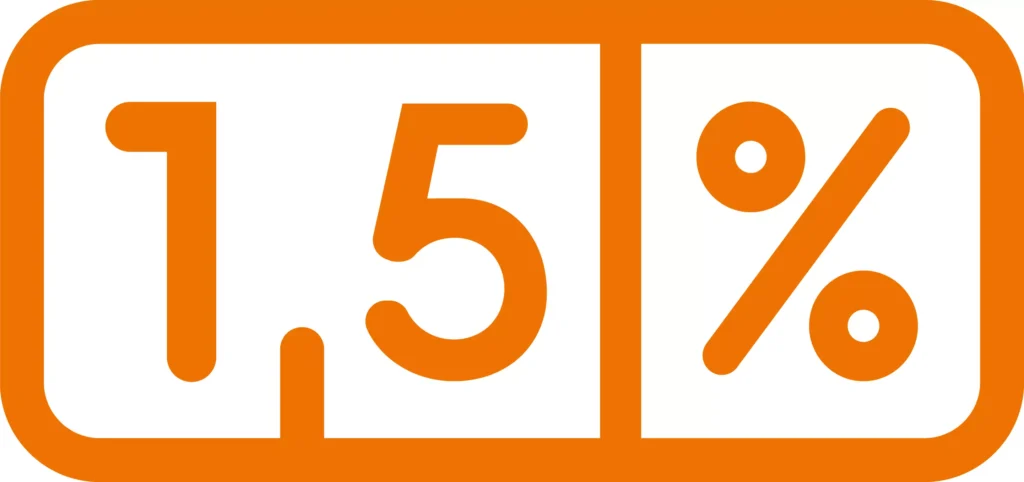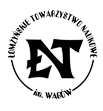People
Kapłan Pejsach
1870-1943
He was a
Hebrew and Yiddish writer, born in Stavisk, Lomzhe region, Poland. In 1883 he was brought to join his father in
Horodishtsh (Gorodishche). He studied in
religious elementary school and yeshivas.
From 1888 he was living in Bialystok.
He turned his attention to teaching, and in 1897 he graduated from the
teachers’ training course in Grodno and opened a city school in 1900. He later devoted himself entirely to
journalism and editorial work. He was
initially a Zionist, later switching to territorialism, and finally (in 1918)
to the Folkspartey (People’s party); and he was a councilman in the Jewish city
council of Bialystok. He did good work on
behalf of Jewish music and published several songbooks in Hebrew and
Yiddish. He debuted in print in 1889 in
Hamelits (The advocate) and contributed to other Hebrew periodicals as well. He was a fierce opponent of Yiddish, calling
it “safa bazuya” (a despised language), but after starting 1904 by writing for
Tog (Day) and Fraynd (Friend) in St. Petersburg, he grew closer to Yiddish, and
from 1914 he was tied in his literary journalistic career to it. He published articles, feature pieces,
stories, reviews, and from time to time poetry in M. Shiva’s Di hayntigetsayt
(Contemporary times), Dos byalistoker vort (The Bialystok word) which he edited
(1913-1914, initially a weekly and later a daily), and other serials in
Bialystok; correspondence pieces in Haynt (Today), Moment (Moment) using the
pen name Z. Vaynshteyn, and Forverts (Forward) under the pen name Tsemekh. His most productive literary-journalistic
work, though, was connected to the daily newspaper Dos naye lebn (The new
life), which he founded in 1919 and existed (in the early 1930s under the title
Unzer lebn [Our life]) until the outbreak of WWII. Almost every day, he wrote for this newspaper
an article, feature, fictional item, theater or film review, using such
pseudonyms as: P. K., Khonen, M. Fuksman, B. Ts-n, Z. Goldshteyn, and
Yedidye. He also edited Byalistoker vort
(Bialystok word) in 1917 (initially a weekly, later a daily) and Byalistoker
almanakh (Bialystok almanac) (1931), and co-edited Byalistoker leksikon
(Bialystok handbook) (1935), among other works.
Kaplan’s ghetto poems were published in Shmerke Katsherginski’s Lider
fun di getos un lagern (Poems of the ghettos and concentration camps) (New
York, 1948), Moyshe Prager’s Min hametsar karati (From the depths I read)
(Jerusalem, 1956), B. Marks’s Der oyfshtand in byalistoker geto (The resistance
in the Bialystok ghetto) (Warsaw: Jewish Historical Institute, 1950), and
Hubert Witt’s Der Fiedler vom Getto: Jiddische Dichtung aus Polen (The fiddler
of the ghetto, Yiddish poetry from Poland) (Leipzig, 1966, 1978). One of Kaplan’s last ghetto poems, entitled
“Rivkele di shabesdike” (Rivkele the Sabbath [girl]), was published in Folks
shtime (Voice of the people) in Warsaw (August 17, 1960). In Yad Vashem in Jerusalem there may be found
copies of his Byalistoker yudnrat (Bialystok Jewish council) and Geyresh
byalistok (Expulsion of Bialystok). In
book and pamphlet form: Di yudishe natsyonal biblyothek in yerusholaim (The
National Jewish Library in Jerusalem) (Odessa: Zionist kopek library,
1911/1912), 18 pp.; Yapanishe mayselekh (Japanese stories) (Bialystok, 1921),
91 pp.; Gezang-oytser far shul un heym (Treasury of songs for school and home),
108 new Yiddish songs with notation (Kaplan’s own songs which he wrote while
running a children’s home, 1914-1915) (Bialystok, 1924), 105 pp. + 64 pp.;
Byalistoker zamelheft, leṭoyves der biliger un umzister kikh (Bialystok
anthology, on behalf of the inexpensive and free kitchen), 3 vols. (Bialystok,
1933-1938). His translations include: M.
Mandelshtam, An ofene brief tsu di rusishe tsienistn (An open letter to the
Russian Zionists) (Vilna: Widow and Brothers Romm, 1904/1905), 16 pp. (several
printings); Y. Zangwill, Der teritoryalizm un zayne gegner (Territorialism and
its opponents) (Warsaw: Medine, 1905/1906), 32 pp.; Lieder-bukh, a zamlung fun
gezangen far khor un solo (Songbook, a collection of songs for chorus and
solo), translated from classical poems with music by Felix Mendelssohn, Franz
Schubert, Robert Schumann, and others, with seven original pieces (Warsaw:
Bikher-far-ale, 1912), 160 pp., second edition (Warsaw, 1914); Krilovs mesholim
(Krykov’s fables) (Bialystok: Kultur-lige, 1918), 78 pp., full edition
(Bialystok: A. Albek, 1921-1922), three parts in 2 vols., 146 pp.; V. Korolenko,
On a loshn (Without a language [original: Bez yazyka]) (Bialystok: Dos bukh,
1921), 202 pp.; Heinrich Mann, Di orime, roman (The poor [original: Die Armen:
Roman] (Bialystok: A. Albek, 1921), 258 pp.; Dmitry Mamin-Sibiryak, Khaneles
mayselakh (Hannah’s tales), under the pen name Yedidye (Bialystok: Kultur-lige,
1921), two parts in one volume; Rudyard Kipling, Der keml un zayn horb (The
camel and his hump [original: “How the Camel Got His Hump”]) (Bialystok: Dos
bukh, 1921), 15 pp.; Der alter kongur (The old kangaroo [original: “The
Sing-Song of Old Man Kangaroo”]) (Bialystok: Dos bukh, 1921), 16 pp.; Shir
hashirim (Song of Songs) (Bialystok: A. Albek, 1922), 27 pp.; Rambam in yidish,
geklibene shriftn (Maimonides in Yiddish, selected writings) (Bialystok: Unzer
prese, 1935), 160 pp. Kaplan also
translated plays, opera, and operettas which were staged 1912-1914 in Yiddish
theaters: Shoshane di tsnue (Shoshana the chaste woman), Khave (Eve),
Tsigayner-libe (Gypsy love), Puptshik (Little guy), and Meydl-mark (Girl
market). Two of them were published:
Pietro Mascagni, Di dorfishe ere (Village honor [original: Cavalleria Rusticana
(Rustic chivalry)]) (Warsaw: Bikher-far-ale, 1912/1913), 22 pp.; Ruggero
Leoncavallo, Di payatsn (The clowns [original: Pagliacci]) (Warsaw:
Bikher-far-ale, 1912), 35 pp. In his
first period, Kaplan not only contributed to many Hebrew-language periodicals,
but he also published a series of books in Hebrew, largely translations, and he
also translated from Hebrew into Yiddish, such as: Dovid Pinski, Gliksfargesene
(Happily forgotten), 16 pp.; Osip Dimov, Shma yisroel (Hear, O Israel), 50 pp.;
M. Ornshteyn, Dos eybike lid (The eternal song)—all: Bialystok: Habima,
1913. He died in the Bialystok
ghetto.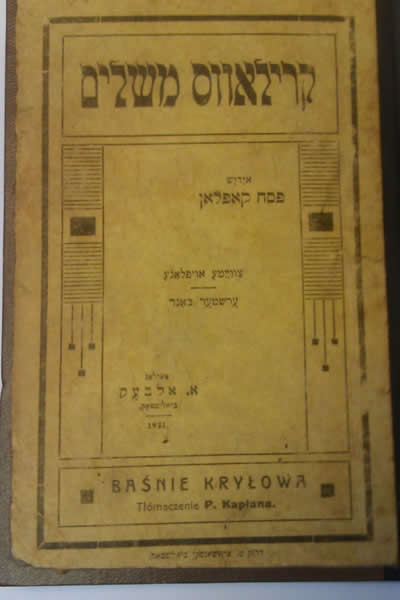
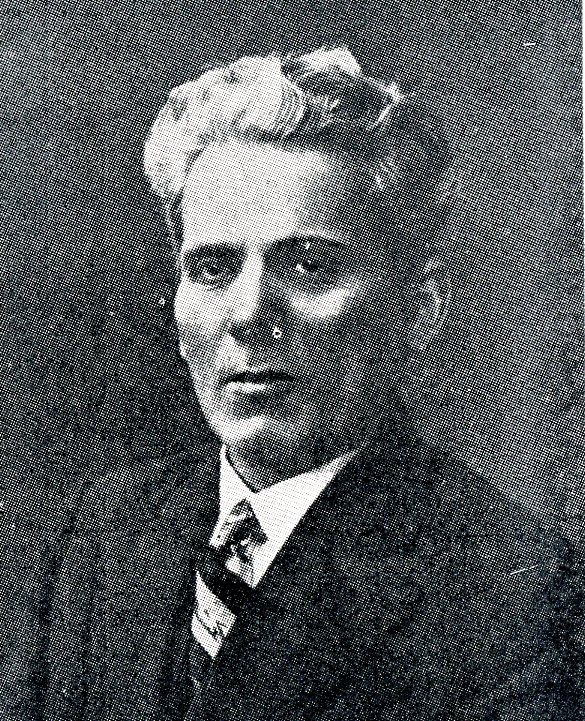
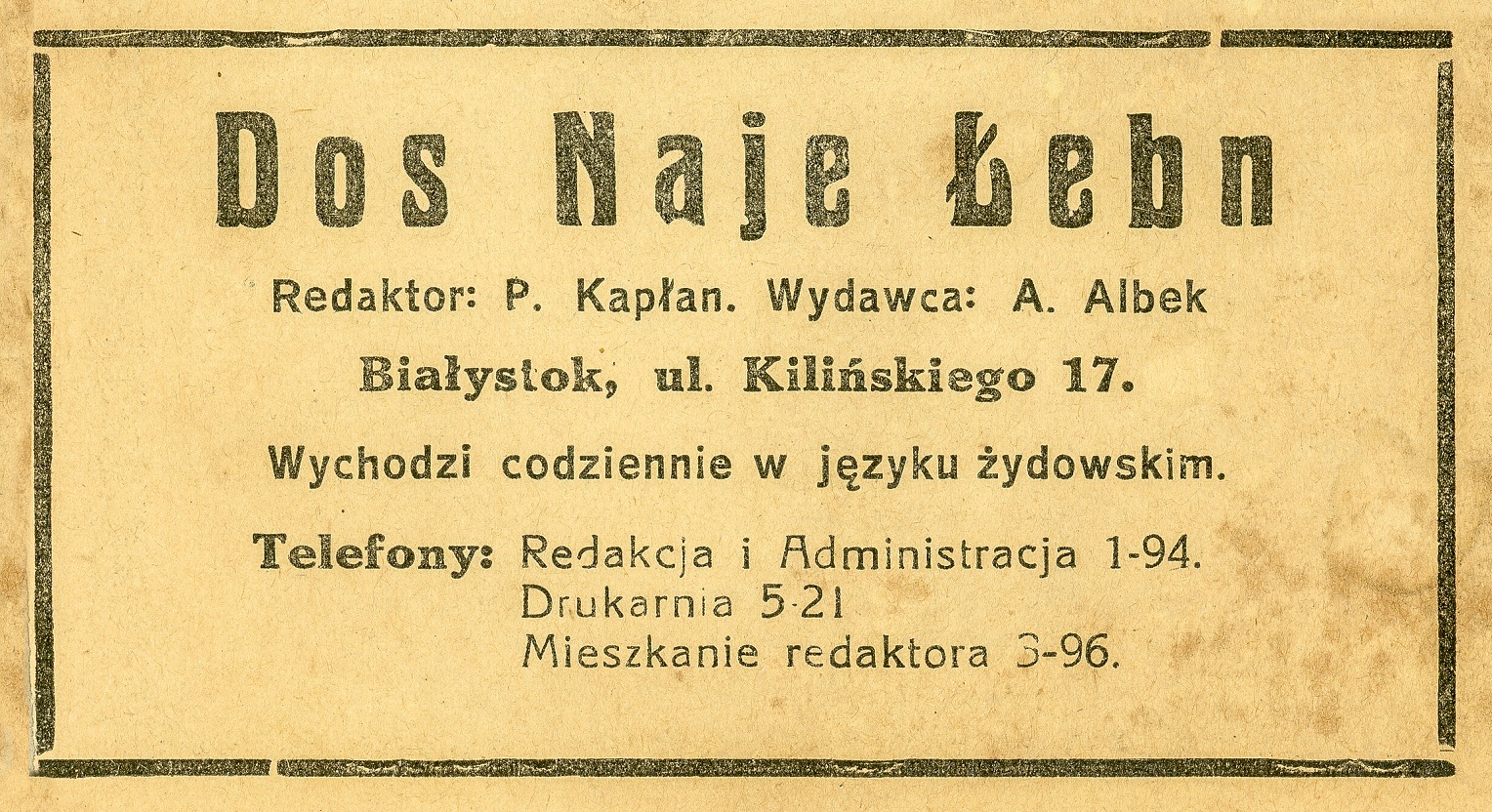
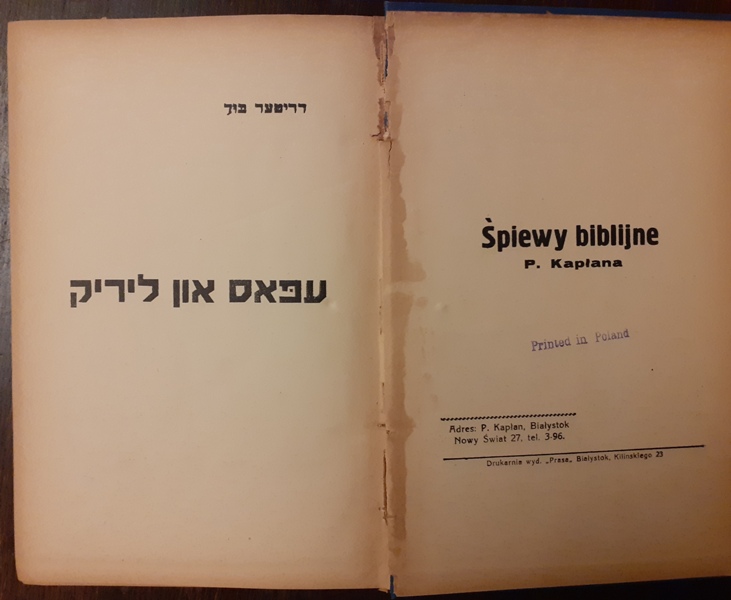



picture:
Dos Naje Łebn
Dos Naje Łebn
Editor: P. Kapłan, Publisher: A.
Albek
Białystok, 17 Kilińskiego Street
Comes out every day in Yiddish
Telephones: Editorial and administration 1-94
Printing House 5-21
Editor`s apartment 3-96
Śpiewy biblijne, ze zbiorów P. Znanieckiego.
2024-02-13 14:49:03 history
Przesuń suwak 

2018-08-24 12:26:39
2018-01-06 19:26:39
2019-04-17 16:36:28








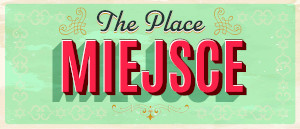
 uzupełnij jewishbialystok@gmail.com
uzupełnij jewishbialystok@gmail.com 
